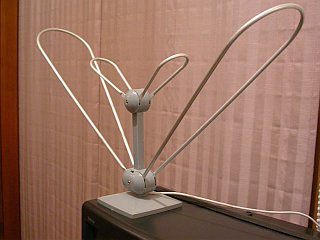Indoor antenna
From Wikipedia, the free encyclopedia
An indoor antenna is a type of radio or TV antenna placed indoors, as opposed to being mounted on the roof. They are usually considered a simple and cheap solution to receive transmissions. An indoor antenna is prone to picking up electrical noise, but digital broadcasts are resistant to this noise.
This article needs additional citations for verification. (April 2015) |

Description
An indoor antenna is a type of radio or TV antenna placed indoors, as opposed to being mounted on the roof.
Use
Indoor antennas are a common solution for cord cutting, with a variety of commercial options.[1] They are usually considered a simple and cheap solution that may work well when the receiver is relatively near to the broadcasting transmitter and the building walls do not shield the radio waves too much.[citation needed]
Being close to other electric or electronic equipment in the building, an indoor antenna is prone to picking up more electrical noise that may interfere with a clear (analog) reception.[2] Used for digital broadcast, the noise is less of a factor than analog broadcast, which recently makes this type of antenna a more popular solution.[citation needed]
Indoor antennas are used for radio reception, particularly the folded dipole constructed from twin-lead,[3] which can be nailed to a skirting board.
See also
References
External links
Wikiwand - on
Seamless Wikipedia browsing. On steroids.
